Business Strategy Report: Vodafone's Strategic Planning and Analysis
VerifiedAdded on 2021/02/19
|15
|4916
|53
Report
AI Summary
This report provides a comprehensive analysis of Vodafone's business strategy. It begins with an introduction to business strategy and Vodafone's mission, vision, and objectives. The report then delves into a PESTLE analysis to evaluate the macro environment, followed by a stakeholder analysis. The internal environment and capabilities are evaluated using SWOT and VRIO frameworks. The report also examines Porter's Five Forces model to assess competitive forces and concludes with the application of various theories and models, including Ansoff matrix and Porter's generic strategies, to devise a strategic action plan for Vodafone, aiming for competitive advantage. The report covers external and internal factors, evaluating the company's strengths, weaknesses, opportunities, and threats, along with its valuable, rare, and inimitable resources.
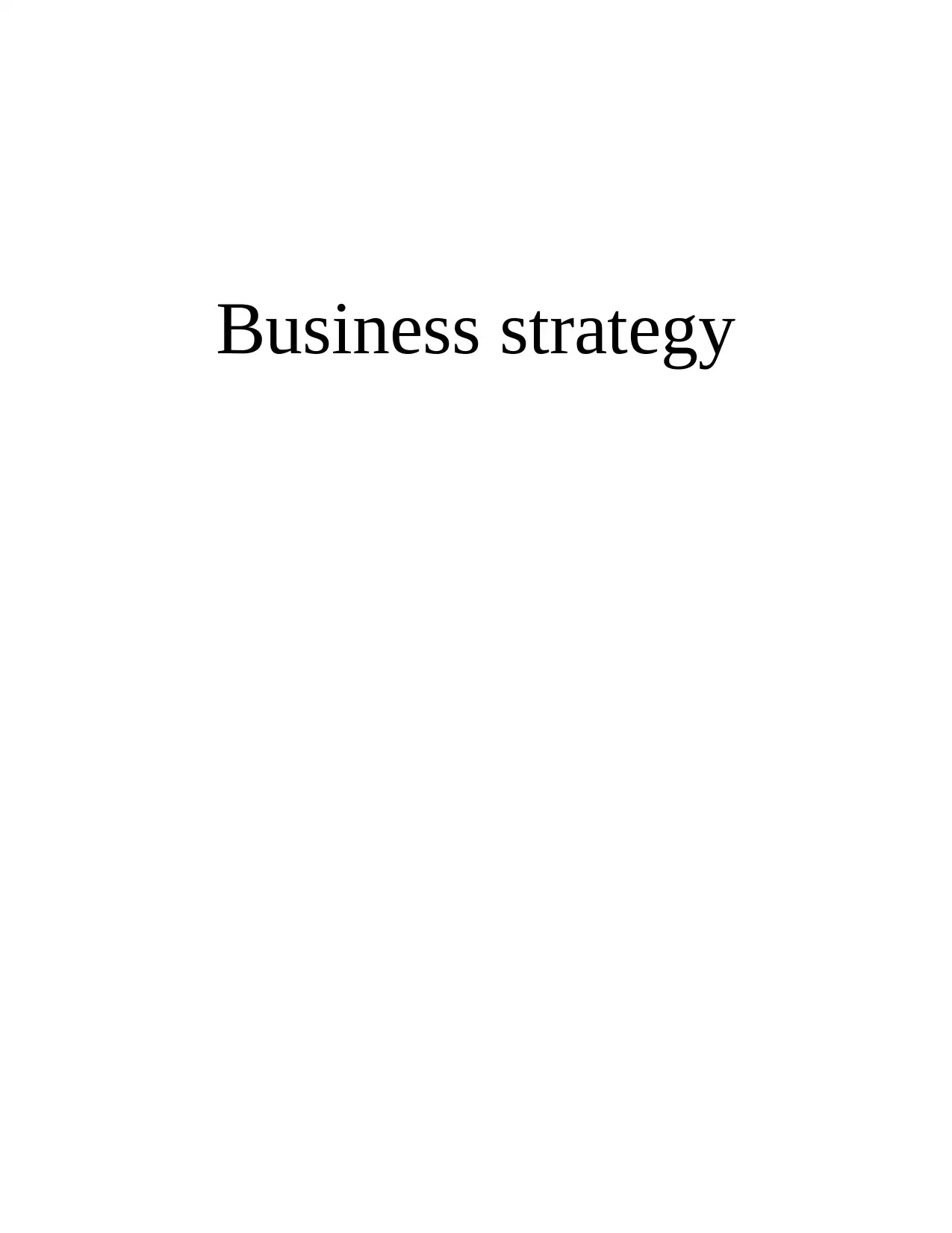
Business strategy
Paraphrase This Document
Need a fresh take? Get an instant paraphrase of this document with our AI Paraphraser

Table of Contents
INTRODUCTION...........................................................................................................................3
TASK 1............................................................................................................................................3
P1 Application of appropriate framework to analyse impact and influence of macro
environment............................................................................................................................3
TASK 2............................................................................................................................................6
P2 Evaluate the internal environment and capabilities...........................................................6
TASK 3............................................................................................................................................9
P3. Porter's Five Force model for evaluating the competitive forces ....................................9
TASK 4..........................................................................................................................................11
P4. Apply a range of theories, concept and model, interpret and devise strategic planning for
Vodafone..............................................................................................................................11
CONCLUSION..............................................................................................................................13
REFERENCES..............................................................................................................................14
INTRODUCTION...........................................................................................................................3
TASK 1............................................................................................................................................3
P1 Application of appropriate framework to analyse impact and influence of macro
environment............................................................................................................................3
TASK 2............................................................................................................................................6
P2 Evaluate the internal environment and capabilities...........................................................6
TASK 3............................................................................................................................................9
P3. Porter's Five Force model for evaluating the competitive forces ....................................9
TASK 4..........................................................................................................................................11
P4. Apply a range of theories, concept and model, interpret and devise strategic planning for
Vodafone..............................................................................................................................11
CONCLUSION..............................................................................................................................13
REFERENCES..............................................................................................................................14
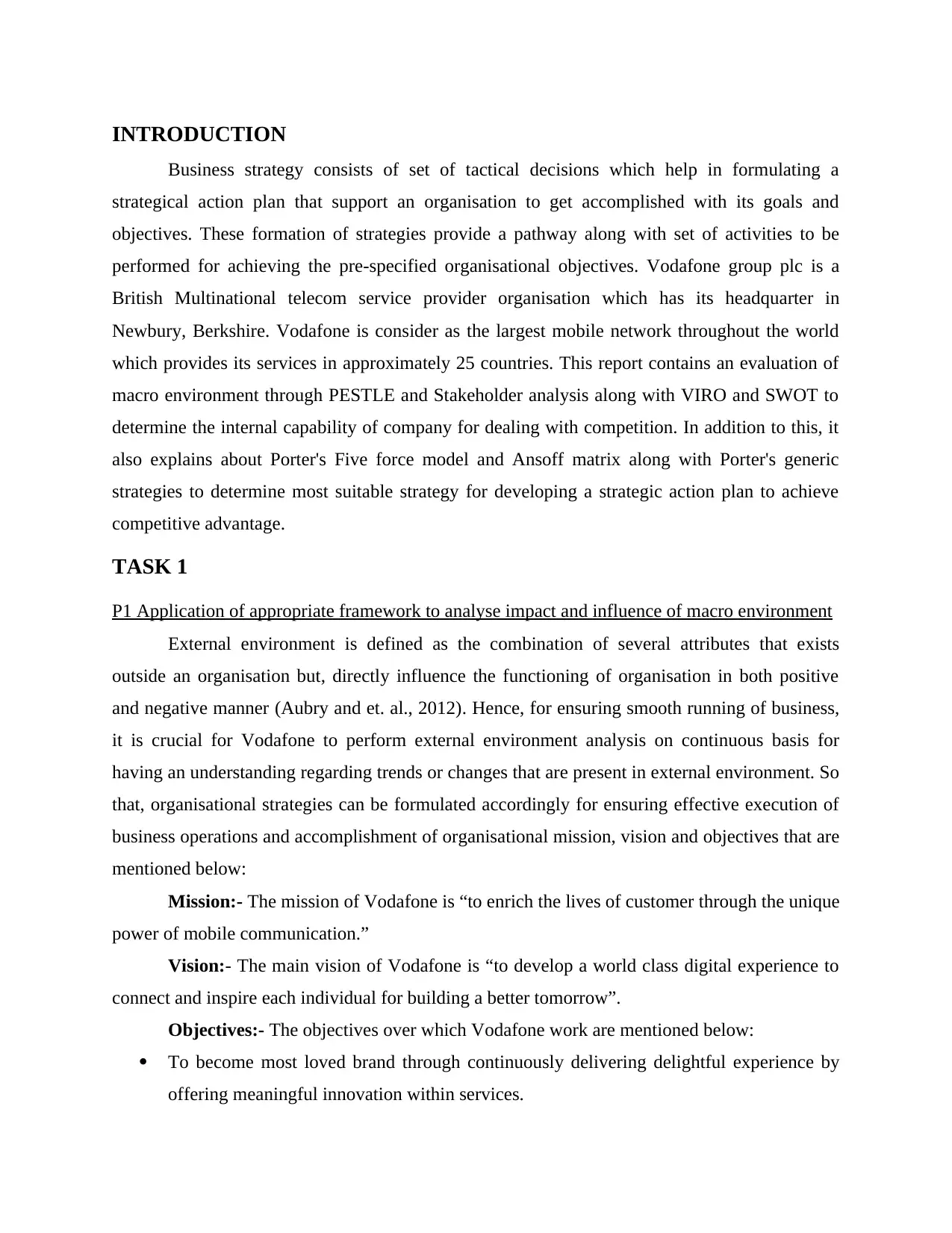
INTRODUCTION
Business strategy consists of set of tactical decisions which help in formulating a
strategical action plan that support an organisation to get accomplished with its goals and
objectives. These formation of strategies provide a pathway along with set of activities to be
performed for achieving the pre-specified organisational objectives. Vodafone group plc is a
British Multinational telecom service provider organisation which has its headquarter in
Newbury, Berkshire. Vodafone is consider as the largest mobile network throughout the world
which provides its services in approximately 25 countries. This report contains an evaluation of
macro environment through PESTLE and Stakeholder analysis along with VIRO and SWOT to
determine the internal capability of company for dealing with competition. In addition to this, it
also explains about Porter's Five force model and Ansoff matrix along with Porter's generic
strategies to determine most suitable strategy for developing a strategic action plan to achieve
competitive advantage.
TASK 1
P1 Application of appropriate framework to analyse impact and influence of macro environment
External environment is defined as the combination of several attributes that exists
outside an organisation but, directly influence the functioning of organisation in both positive
and negative manner (Aubry and et. al., 2012). Hence, for ensuring smooth running of business,
it is crucial for Vodafone to perform external environment analysis on continuous basis for
having an understanding regarding trends or changes that are present in external environment. So
that, organisational strategies can be formulated accordingly for ensuring effective execution of
business operations and accomplishment of organisational mission, vision and objectives that are
mentioned below:
Mission:- The mission of Vodafone is “to enrich the lives of customer through the unique
power of mobile communication.”
Vision:- The main vision of Vodafone is “to develop a world class digital experience to
connect and inspire each individual for building a better tomorrow”.
Objectives:- The objectives over which Vodafone work are mentioned below:
To become most loved brand through continuously delivering delightful experience by
offering meaningful innovation within services.
Business strategy consists of set of tactical decisions which help in formulating a
strategical action plan that support an organisation to get accomplished with its goals and
objectives. These formation of strategies provide a pathway along with set of activities to be
performed for achieving the pre-specified organisational objectives. Vodafone group plc is a
British Multinational telecom service provider organisation which has its headquarter in
Newbury, Berkshire. Vodafone is consider as the largest mobile network throughout the world
which provides its services in approximately 25 countries. This report contains an evaluation of
macro environment through PESTLE and Stakeholder analysis along with VIRO and SWOT to
determine the internal capability of company for dealing with competition. In addition to this, it
also explains about Porter's Five force model and Ansoff matrix along with Porter's generic
strategies to determine most suitable strategy for developing a strategic action plan to achieve
competitive advantage.
TASK 1
P1 Application of appropriate framework to analyse impact and influence of macro environment
External environment is defined as the combination of several attributes that exists
outside an organisation but, directly influence the functioning of organisation in both positive
and negative manner (Aubry and et. al., 2012). Hence, for ensuring smooth running of business,
it is crucial for Vodafone to perform external environment analysis on continuous basis for
having an understanding regarding trends or changes that are present in external environment. So
that, organisational strategies can be formulated accordingly for ensuring effective execution of
business operations and accomplishment of organisational mission, vision and objectives that are
mentioned below:
Mission:- The mission of Vodafone is “to enrich the lives of customer through the unique
power of mobile communication.”
Vision:- The main vision of Vodafone is “to develop a world class digital experience to
connect and inspire each individual for building a better tomorrow”.
Objectives:- The objectives over which Vodafone work are mentioned below:
To become most loved brand through continuously delivering delightful experience by
offering meaningful innovation within services.
⊘ This is a preview!⊘
Do you want full access?
Subscribe today to unlock all pages.

Trusted by 1+ million students worldwide
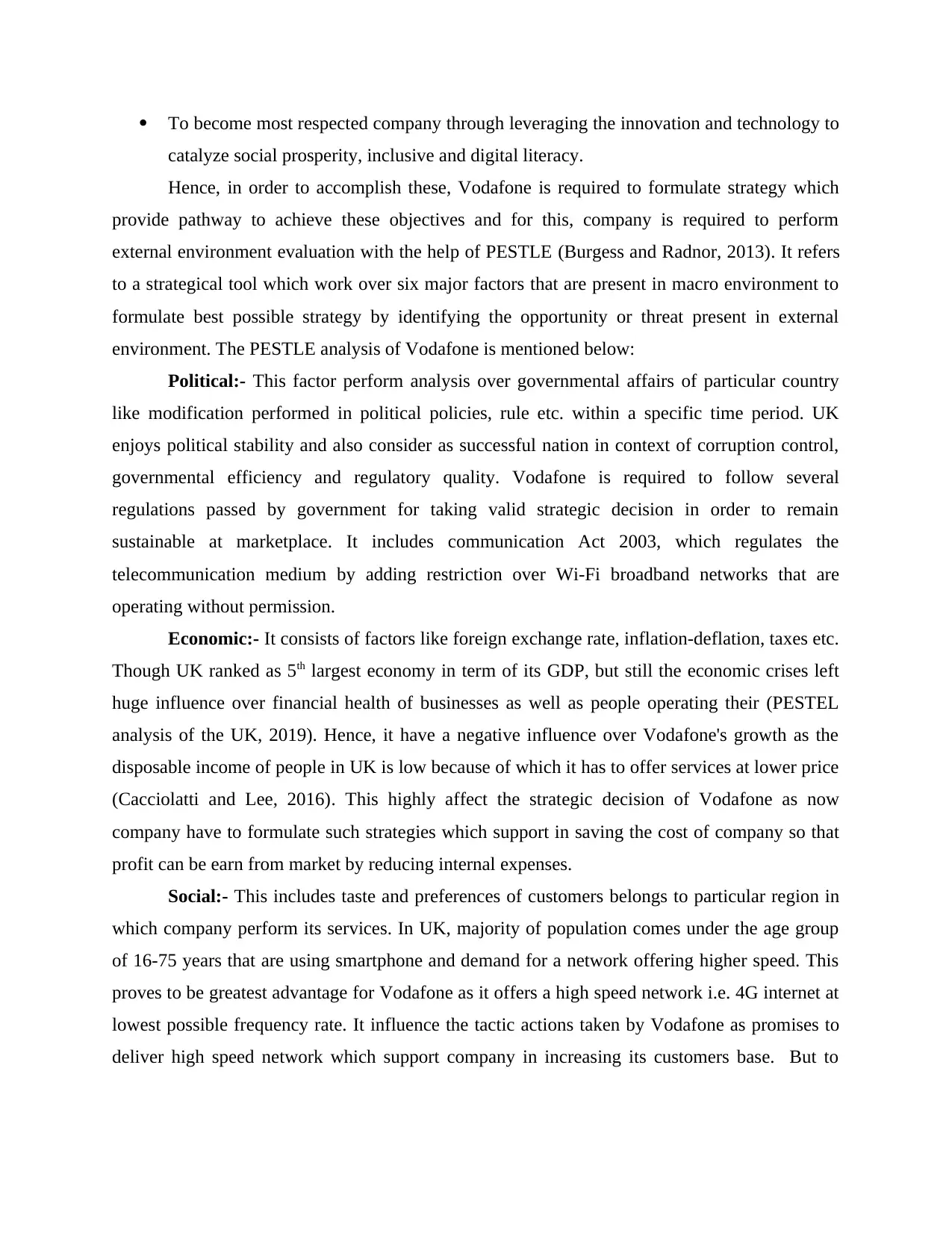
To become most respected company through leveraging the innovation and technology to
catalyze social prosperity, inclusive and digital literacy.
Hence, in order to accomplish these, Vodafone is required to formulate strategy which
provide pathway to achieve these objectives and for this, company is required to perform
external environment evaluation with the help of PESTLE (Burgess and Radnor, 2013). It refers
to a strategical tool which work over six major factors that are present in macro environment to
formulate best possible strategy by identifying the opportunity or threat present in external
environment. The PESTLE analysis of Vodafone is mentioned below:
Political:- This factor perform analysis over governmental affairs of particular country
like modification performed in political policies, rule etc. within a specific time period. UK
enjoys political stability and also consider as successful nation in context of corruption control,
governmental efficiency and regulatory quality. Vodafone is required to follow several
regulations passed by government for taking valid strategic decision in order to remain
sustainable at marketplace. It includes communication Act 2003, which regulates the
telecommunication medium by adding restriction over Wi-Fi broadband networks that are
operating without permission.
Economic:- It consists of factors like foreign exchange rate, inflation-deflation, taxes etc.
Though UK ranked as 5th largest economy in term of its GDP, but still the economic crises left
huge influence over financial health of businesses as well as people operating their (PESTEL
analysis of the UK, 2019). Hence, it have a negative influence over Vodafone's growth as the
disposable income of people in UK is low because of which it has to offer services at lower price
(Cacciolatti and Lee, 2016). This highly affect the strategic decision of Vodafone as now
company have to formulate such strategies which support in saving the cost of company so that
profit can be earn from market by reducing internal expenses.
Social:- This includes taste and preferences of customers belongs to particular region in
which company perform its services. In UK, majority of population comes under the age group
of 16-75 years that are using smartphone and demand for a network offering higher speed. This
proves to be greatest advantage for Vodafone as it offers a high speed network i.e. 4G internet at
lowest possible frequency rate. It influence the tactic actions taken by Vodafone as promises to
deliver high speed network which support company in increasing its customers base. But to
catalyze social prosperity, inclusive and digital literacy.
Hence, in order to accomplish these, Vodafone is required to formulate strategy which
provide pathway to achieve these objectives and for this, company is required to perform
external environment evaluation with the help of PESTLE (Burgess and Radnor, 2013). It refers
to a strategical tool which work over six major factors that are present in macro environment to
formulate best possible strategy by identifying the opportunity or threat present in external
environment. The PESTLE analysis of Vodafone is mentioned below:
Political:- This factor perform analysis over governmental affairs of particular country
like modification performed in political policies, rule etc. within a specific time period. UK
enjoys political stability and also consider as successful nation in context of corruption control,
governmental efficiency and regulatory quality. Vodafone is required to follow several
regulations passed by government for taking valid strategic decision in order to remain
sustainable at marketplace. It includes communication Act 2003, which regulates the
telecommunication medium by adding restriction over Wi-Fi broadband networks that are
operating without permission.
Economic:- It consists of factors like foreign exchange rate, inflation-deflation, taxes etc.
Though UK ranked as 5th largest economy in term of its GDP, but still the economic crises left
huge influence over financial health of businesses as well as people operating their (PESTEL
analysis of the UK, 2019). Hence, it have a negative influence over Vodafone's growth as the
disposable income of people in UK is low because of which it has to offer services at lower price
(Cacciolatti and Lee, 2016). This highly affect the strategic decision of Vodafone as now
company have to formulate such strategies which support in saving the cost of company so that
profit can be earn from market by reducing internal expenses.
Social:- This includes taste and preferences of customers belongs to particular region in
which company perform its services. In UK, majority of population comes under the age group
of 16-75 years that are using smartphone and demand for a network offering higher speed. This
proves to be greatest advantage for Vodafone as it offers a high speed network i.e. 4G internet at
lowest possible frequency rate. It influence the tactic actions taken by Vodafone as promises to
deliver high speed network which support company in increasing its customers base. But to
Paraphrase This Document
Need a fresh take? Get an instant paraphrase of this document with our AI Paraphraser
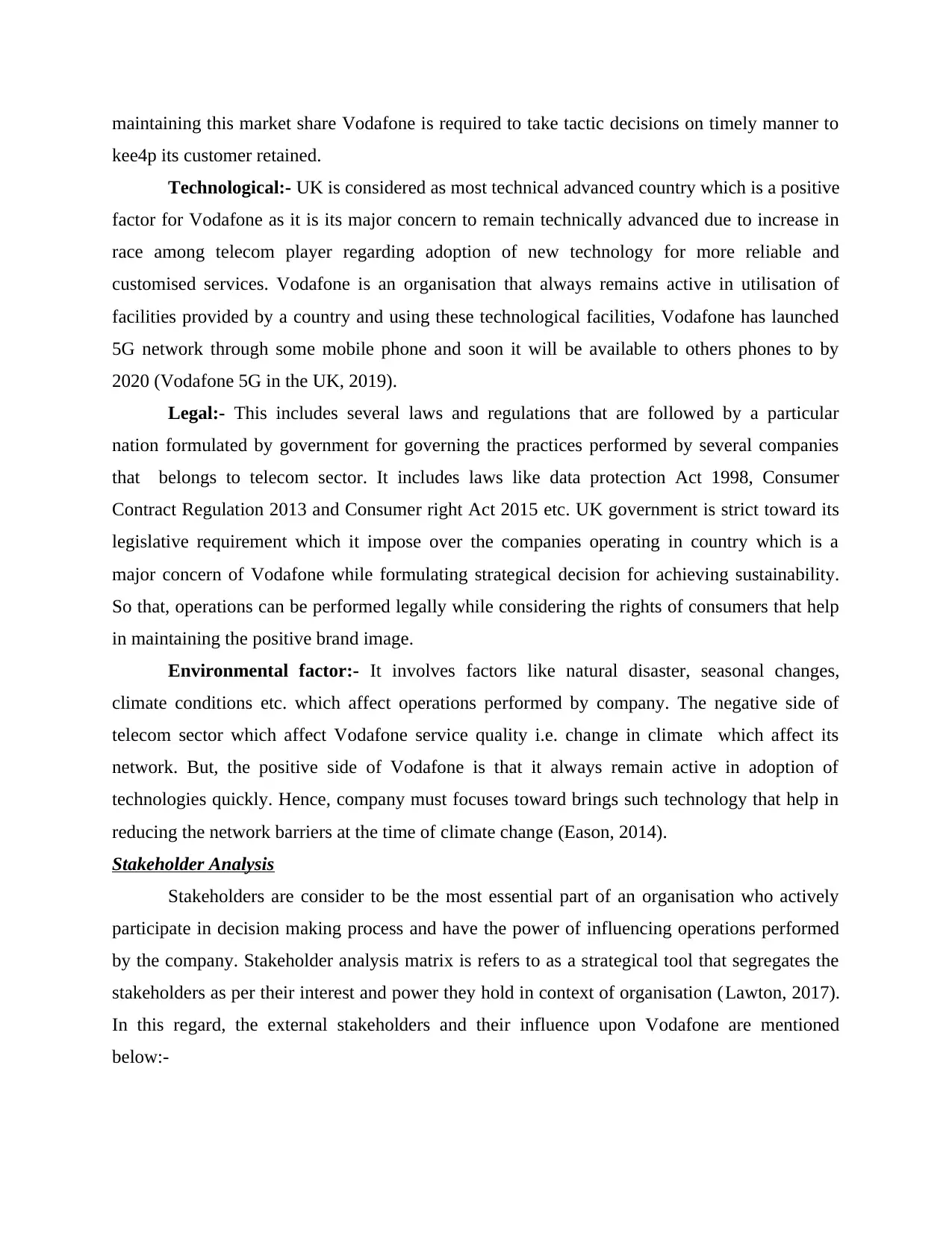
maintaining this market share Vodafone is required to take tactic decisions on timely manner to
kee4p its customer retained.
Technological:- UK is considered as most technical advanced country which is a positive
factor for Vodafone as it is its major concern to remain technically advanced due to increase in
race among telecom player regarding adoption of new technology for more reliable and
customised services. Vodafone is an organisation that always remains active in utilisation of
facilities provided by a country and using these technological facilities, Vodafone has launched
5G network through some mobile phone and soon it will be available to others phones to by
2020 (Vodafone 5G in the UK, 2019).
Legal:- This includes several laws and regulations that are followed by a particular
nation formulated by government for governing the practices performed by several companies
that belongs to telecom sector. It includes laws like data protection Act 1998, Consumer
Contract Regulation 2013 and Consumer right Act 2015 etc. UK government is strict toward its
legislative requirement which it impose over the companies operating in country which is a
major concern of Vodafone while formulating strategical decision for achieving sustainability.
So that, operations can be performed legally while considering the rights of consumers that help
in maintaining the positive brand image.
Environmental factor:- It involves factors like natural disaster, seasonal changes,
climate conditions etc. which affect operations performed by company. The negative side of
telecom sector which affect Vodafone service quality i.e. change in climate which affect its
network. But, the positive side of Vodafone is that it always remain active in adoption of
technologies quickly. Hence, company must focuses toward brings such technology that help in
reducing the network barriers at the time of climate change (Eason, 2014).
Stakeholder Analysis
Stakeholders are consider to be the most essential part of an organisation who actively
participate in decision making process and have the power of influencing operations performed
by the company. Stakeholder analysis matrix is refers to as a strategical tool that segregates the
stakeholders as per their interest and power they hold in context of organisation (Lawton, 2017).
In this regard, the external stakeholders and their influence upon Vodafone are mentioned
below:-
kee4p its customer retained.
Technological:- UK is considered as most technical advanced country which is a positive
factor for Vodafone as it is its major concern to remain technically advanced due to increase in
race among telecom player regarding adoption of new technology for more reliable and
customised services. Vodafone is an organisation that always remains active in utilisation of
facilities provided by a country and using these technological facilities, Vodafone has launched
5G network through some mobile phone and soon it will be available to others phones to by
2020 (Vodafone 5G in the UK, 2019).
Legal:- This includes several laws and regulations that are followed by a particular
nation formulated by government for governing the practices performed by several companies
that belongs to telecom sector. It includes laws like data protection Act 1998, Consumer
Contract Regulation 2013 and Consumer right Act 2015 etc. UK government is strict toward its
legislative requirement which it impose over the companies operating in country which is a
major concern of Vodafone while formulating strategical decision for achieving sustainability.
So that, operations can be performed legally while considering the rights of consumers that help
in maintaining the positive brand image.
Environmental factor:- It involves factors like natural disaster, seasonal changes,
climate conditions etc. which affect operations performed by company. The negative side of
telecom sector which affect Vodafone service quality i.e. change in climate which affect its
network. But, the positive side of Vodafone is that it always remain active in adoption of
technologies quickly. Hence, company must focuses toward brings such technology that help in
reducing the network barriers at the time of climate change (Eason, 2014).
Stakeholder Analysis
Stakeholders are consider to be the most essential part of an organisation who actively
participate in decision making process and have the power of influencing operations performed
by the company. Stakeholder analysis matrix is refers to as a strategical tool that segregates the
stakeholders as per their interest and power they hold in context of organisation (Lawton, 2017).
In this regard, the external stakeholders and their influence upon Vodafone are mentioned
below:-
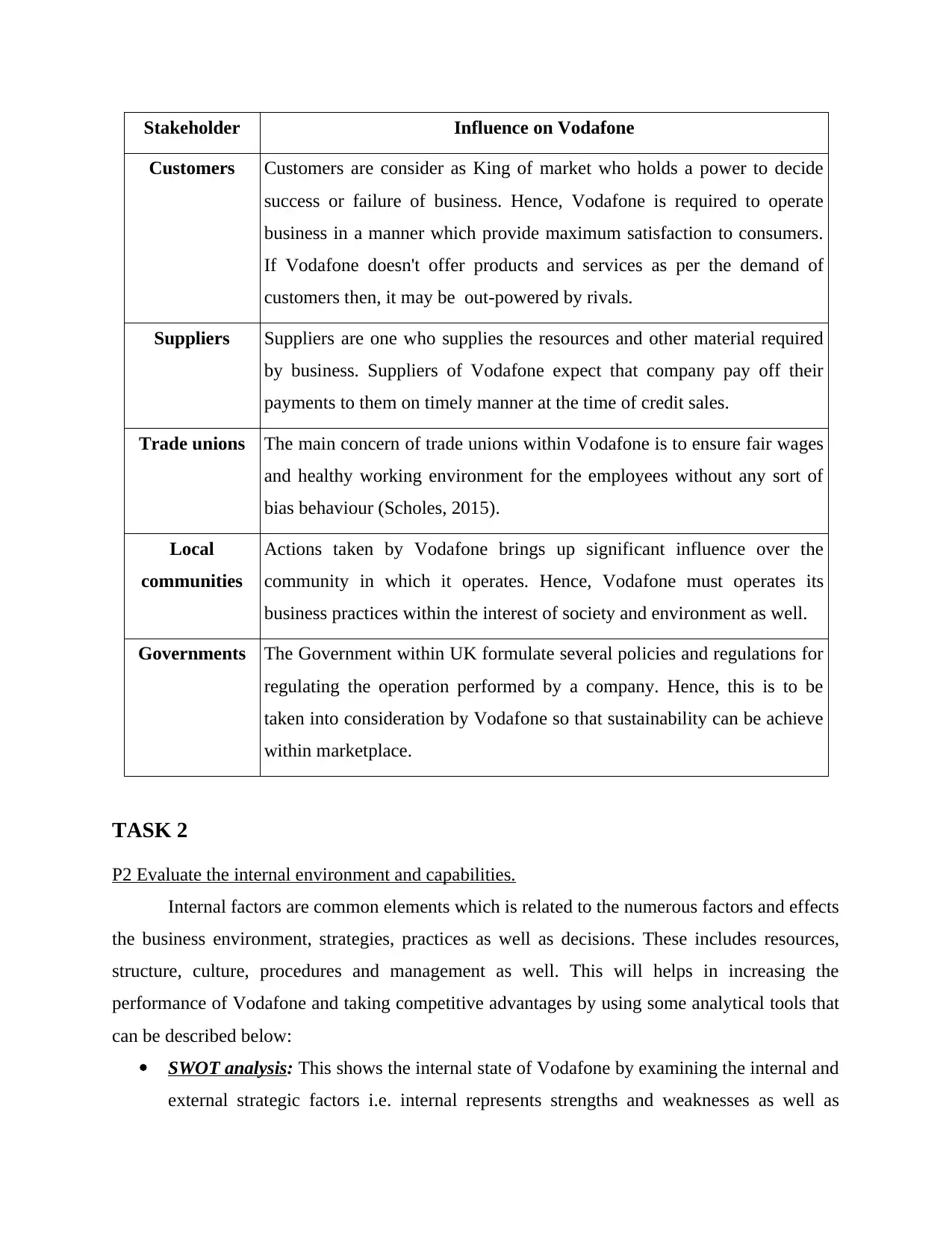
Stakeholder Influence on Vodafone
Customers Customers are consider as King of market who holds a power to decide
success or failure of business. Hence, Vodafone is required to operate
business in a manner which provide maximum satisfaction to consumers.
If Vodafone doesn't offer products and services as per the demand of
customers then, it may be out-powered by rivals.
Suppliers Suppliers are one who supplies the resources and other material required
by business. Suppliers of Vodafone expect that company pay off their
payments to them on timely manner at the time of credit sales.
Trade unions The main concern of trade unions within Vodafone is to ensure fair wages
and healthy working environment for the employees without any sort of
bias behaviour (Scholes, 2015).
Local
communities
Actions taken by Vodafone brings up significant influence over the
community in which it operates. Hence, Vodafone must operates its
business practices within the interest of society and environment as well.
Governments The Government within UK formulate several policies and regulations for
regulating the operation performed by a company. Hence, this is to be
taken into consideration by Vodafone so that sustainability can be achieve
within marketplace.
TASK 2
P2 Evaluate the internal environment and capabilities.
Internal factors are common elements which is related to the numerous factors and effects
the business environment, strategies, practices as well as decisions. These includes resources,
structure, culture, procedures and management as well. This will helps in increasing the
performance of Vodafone and taking competitive advantages by using some analytical tools that
can be described below:
SWOT analysis: This shows the internal state of Vodafone by examining the internal and
external strategic factors i.e. internal represents strengths and weaknesses as well as
Customers Customers are consider as King of market who holds a power to decide
success or failure of business. Hence, Vodafone is required to operate
business in a manner which provide maximum satisfaction to consumers.
If Vodafone doesn't offer products and services as per the demand of
customers then, it may be out-powered by rivals.
Suppliers Suppliers are one who supplies the resources and other material required
by business. Suppliers of Vodafone expect that company pay off their
payments to them on timely manner at the time of credit sales.
Trade unions The main concern of trade unions within Vodafone is to ensure fair wages
and healthy working environment for the employees without any sort of
bias behaviour (Scholes, 2015).
Local
communities
Actions taken by Vodafone brings up significant influence over the
community in which it operates. Hence, Vodafone must operates its
business practices within the interest of society and environment as well.
Governments The Government within UK formulate several policies and regulations for
regulating the operation performed by a company. Hence, this is to be
taken into consideration by Vodafone so that sustainability can be achieve
within marketplace.
TASK 2
P2 Evaluate the internal environment and capabilities.
Internal factors are common elements which is related to the numerous factors and effects
the business environment, strategies, practices as well as decisions. These includes resources,
structure, culture, procedures and management as well. This will helps in increasing the
performance of Vodafone and taking competitive advantages by using some analytical tools that
can be described below:
SWOT analysis: This shows the internal state of Vodafone by examining the internal and
external strategic factors i.e. internal represents strengths and weaknesses as well as
⊘ This is a preview!⊘
Do you want full access?
Subscribe today to unlock all pages.

Trusted by 1+ million students worldwide
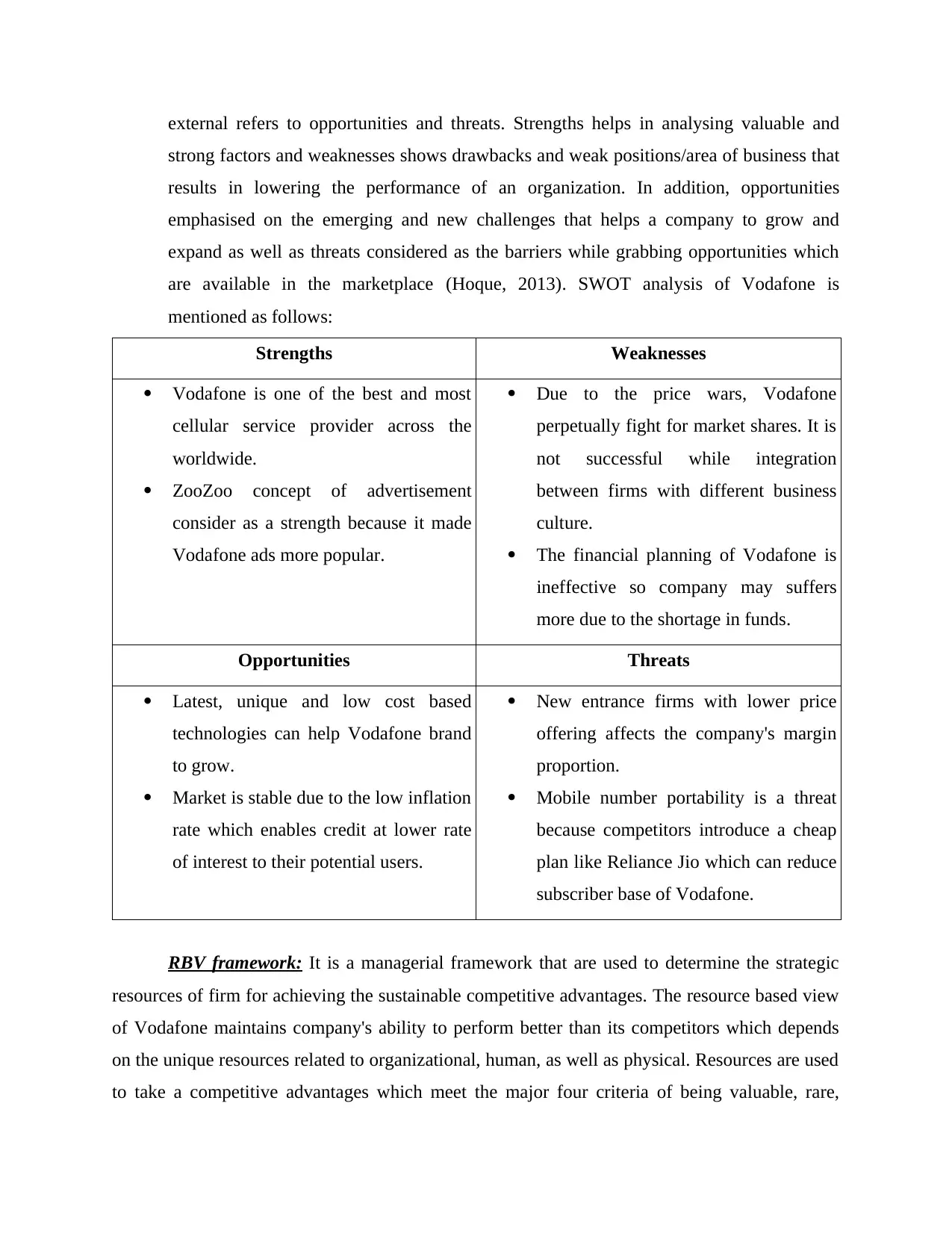
external refers to opportunities and threats. Strengths helps in analysing valuable and
strong factors and weaknesses shows drawbacks and weak positions/area of business that
results in lowering the performance of an organization. In addition, opportunities
emphasised on the emerging and new challenges that helps a company to grow and
expand as well as threats considered as the barriers while grabbing opportunities which
are available in the marketplace (Hoque, 2013). SWOT analysis of Vodafone is
mentioned as follows:
Strengths Weaknesses
Vodafone is one of the best and most
cellular service provider across the
worldwide.
ZooZoo concept of advertisement
consider as a strength because it made
Vodafone ads more popular.
Due to the price wars, Vodafone
perpetually fight for market shares. It is
not successful while integration
between firms with different business
culture.
The financial planning of Vodafone is
ineffective so company may suffers
more due to the shortage in funds.
Opportunities Threats
Latest, unique and low cost based
technologies can help Vodafone brand
to grow.
Market is stable due to the low inflation
rate which enables credit at lower rate
of interest to their potential users.
New entrance firms with lower price
offering affects the company's margin
proportion.
Mobile number portability is a threat
because competitors introduce a cheap
plan like Reliance Jio which can reduce
subscriber base of Vodafone.
RBV framework: It is a managerial framework that are used to determine the strategic
resources of firm for achieving the sustainable competitive advantages. The resource based view
of Vodafone maintains company's ability to perform better than its competitors which depends
on the unique resources related to organizational, human, as well as physical. Resources are used
to take a competitive advantages which meet the major four criteria of being valuable, rare,
strong factors and weaknesses shows drawbacks and weak positions/area of business that
results in lowering the performance of an organization. In addition, opportunities
emphasised on the emerging and new challenges that helps a company to grow and
expand as well as threats considered as the barriers while grabbing opportunities which
are available in the marketplace (Hoque, 2013). SWOT analysis of Vodafone is
mentioned as follows:
Strengths Weaknesses
Vodafone is one of the best and most
cellular service provider across the
worldwide.
ZooZoo concept of advertisement
consider as a strength because it made
Vodafone ads more popular.
Due to the price wars, Vodafone
perpetually fight for market shares. It is
not successful while integration
between firms with different business
culture.
The financial planning of Vodafone is
ineffective so company may suffers
more due to the shortage in funds.
Opportunities Threats
Latest, unique and low cost based
technologies can help Vodafone brand
to grow.
Market is stable due to the low inflation
rate which enables credit at lower rate
of interest to their potential users.
New entrance firms with lower price
offering affects the company's margin
proportion.
Mobile number portability is a threat
because competitors introduce a cheap
plan like Reliance Jio which can reduce
subscriber base of Vodafone.
RBV framework: It is a managerial framework that are used to determine the strategic
resources of firm for achieving the sustainable competitive advantages. The resource based view
of Vodafone maintains company's ability to perform better than its competitors which depends
on the unique resources related to organizational, human, as well as physical. Resources are used
to take a competitive advantages which meet the major four criteria of being valuable, rare,
Paraphrase This Document
Need a fresh take? Get an instant paraphrase of this document with our AI Paraphraser
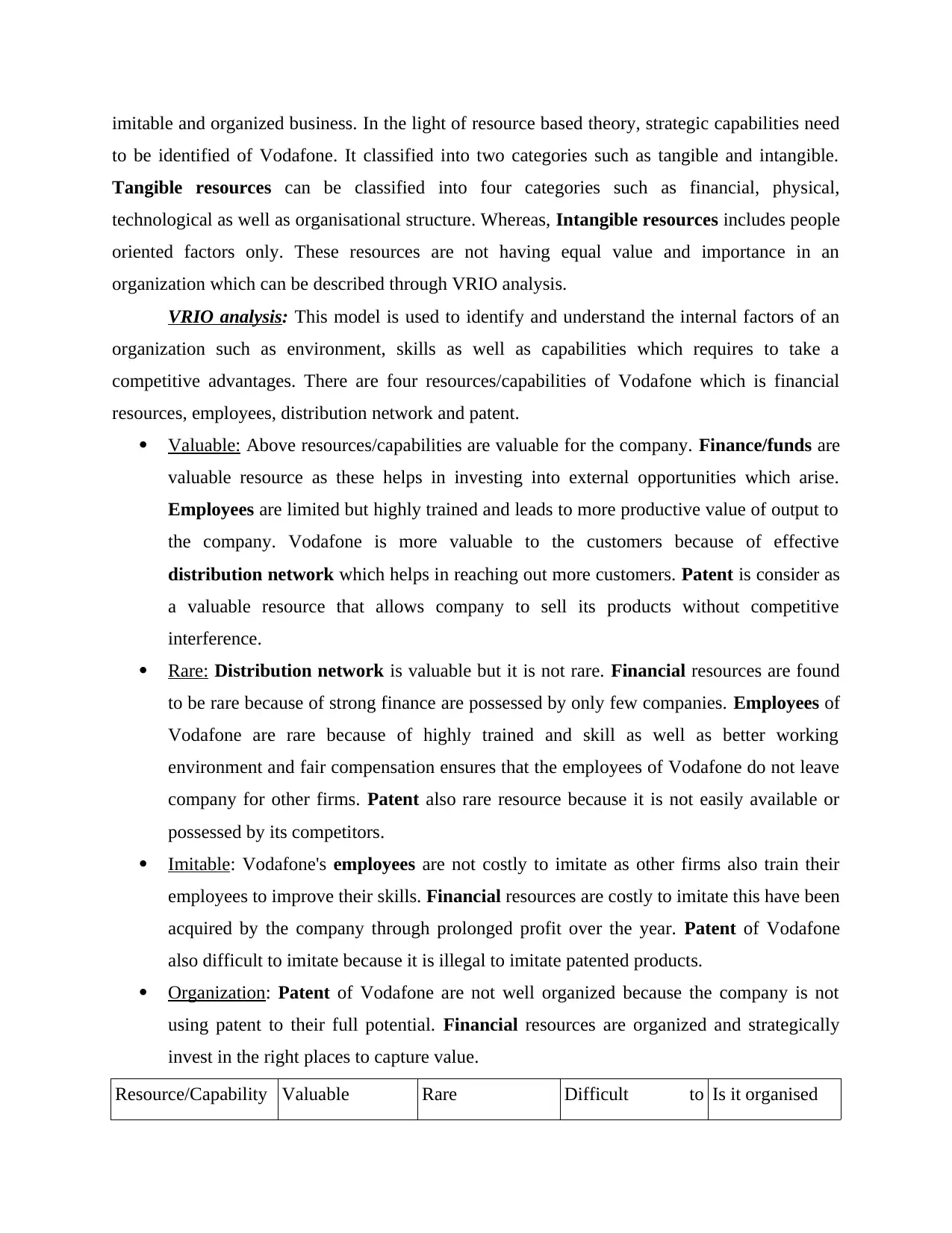
imitable and organized business. In the light of resource based theory, strategic capabilities need
to be identified of Vodafone. It classified into two categories such as tangible and intangible.
Tangible resources can be classified into four categories such as financial, physical,
technological as well as organisational structure. Whereas, Intangible resources includes people
oriented factors only. These resources are not having equal value and importance in an
organization which can be described through VRIO analysis.
VRIO analysis: This model is used to identify and understand the internal factors of an
organization such as environment, skills as well as capabilities which requires to take a
competitive advantages. There are four resources/capabilities of Vodafone which is financial
resources, employees, distribution network and patent.
Valuable: Above resources/capabilities are valuable for the company. Finance/funds are
valuable resource as these helps in investing into external opportunities which arise.
Employees are limited but highly trained and leads to more productive value of output to
the company. Vodafone is more valuable to the customers because of effective
distribution network which helps in reaching out more customers. Patent is consider as
a valuable resource that allows company to sell its products without competitive
interference.
Rare: Distribution network is valuable but it is not rare. Financial resources are found
to be rare because of strong finance are possessed by only few companies. Employees of
Vodafone are rare because of highly trained and skill as well as better working
environment and fair compensation ensures that the employees of Vodafone do not leave
company for other firms. Patent also rare resource because it is not easily available or
possessed by its competitors.
Imitable: Vodafone's employees are not costly to imitate as other firms also train their
employees to improve their skills. Financial resources are costly to imitate this have been
acquired by the company through prolonged profit over the year. Patent of Vodafone
also difficult to imitate because it is illegal to imitate patented products.
Organization: Patent of Vodafone are not well organized because the company is not
using patent to their full potential. Financial resources are organized and strategically
invest in the right places to capture value.
Resource/Capability Valuable Rare Difficult to Is it organised
to be identified of Vodafone. It classified into two categories such as tangible and intangible.
Tangible resources can be classified into four categories such as financial, physical,
technological as well as organisational structure. Whereas, Intangible resources includes people
oriented factors only. These resources are not having equal value and importance in an
organization which can be described through VRIO analysis.
VRIO analysis: This model is used to identify and understand the internal factors of an
organization such as environment, skills as well as capabilities which requires to take a
competitive advantages. There are four resources/capabilities of Vodafone which is financial
resources, employees, distribution network and patent.
Valuable: Above resources/capabilities are valuable for the company. Finance/funds are
valuable resource as these helps in investing into external opportunities which arise.
Employees are limited but highly trained and leads to more productive value of output to
the company. Vodafone is more valuable to the customers because of effective
distribution network which helps in reaching out more customers. Patent is consider as
a valuable resource that allows company to sell its products without competitive
interference.
Rare: Distribution network is valuable but it is not rare. Financial resources are found
to be rare because of strong finance are possessed by only few companies. Employees of
Vodafone are rare because of highly trained and skill as well as better working
environment and fair compensation ensures that the employees of Vodafone do not leave
company for other firms. Patent also rare resource because it is not easily available or
possessed by its competitors.
Imitable: Vodafone's employees are not costly to imitate as other firms also train their
employees to improve their skills. Financial resources are costly to imitate this have been
acquired by the company through prolonged profit over the year. Patent of Vodafone
also difficult to imitate because it is illegal to imitate patented products.
Organization: Patent of Vodafone are not well organized because the company is not
using patent to their full potential. Financial resources are organized and strategically
invest in the right places to capture value.
Resource/Capability Valuable Rare Difficult to Is it organised
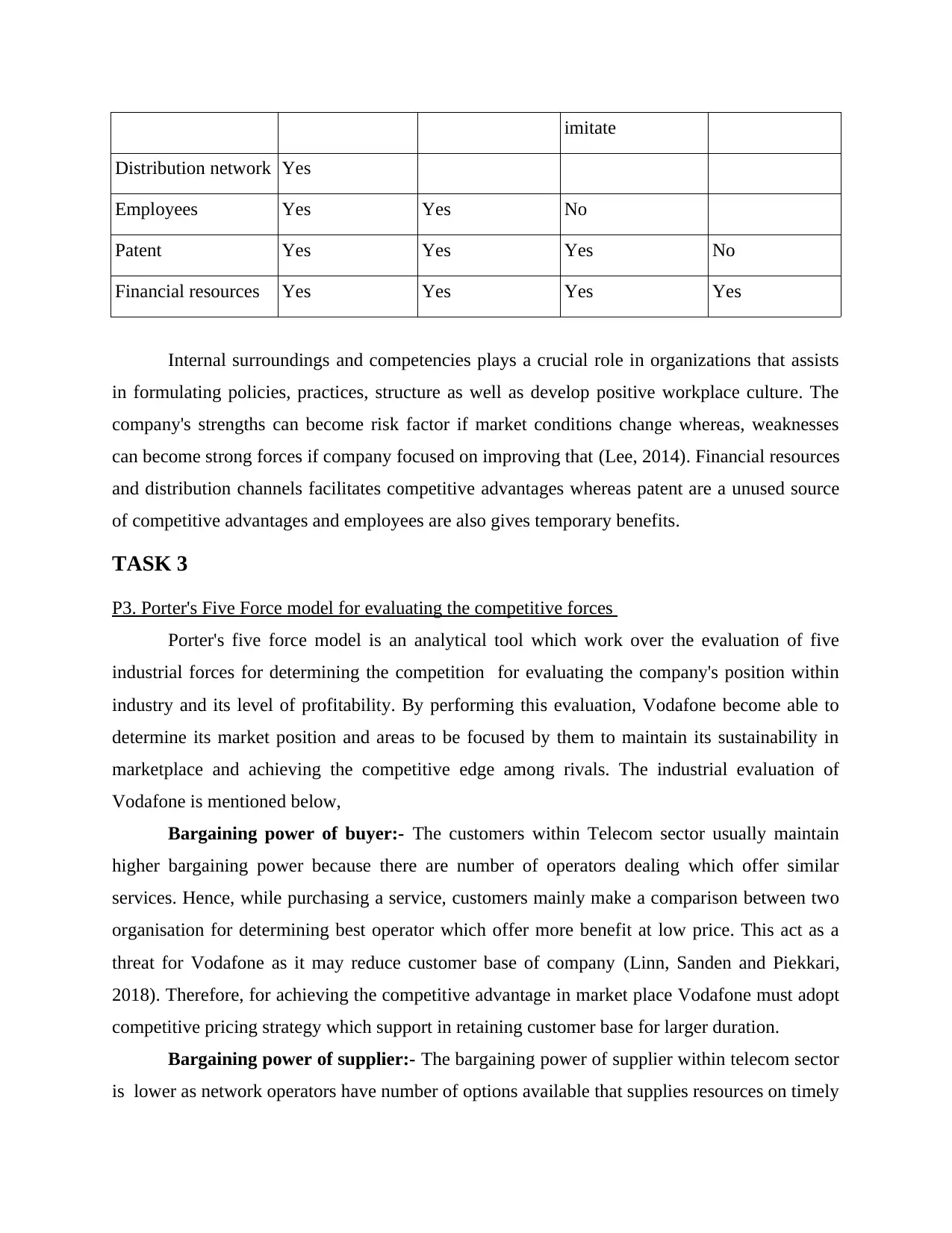
imitate
Distribution network Yes
Employees Yes Yes No
Patent Yes Yes Yes No
Financial resources Yes Yes Yes Yes
Internal surroundings and competencies plays a crucial role in organizations that assists
in formulating policies, practices, structure as well as develop positive workplace culture. The
company's strengths can become risk factor if market conditions change whereas, weaknesses
can become strong forces if company focused on improving that (Lee, 2014). Financial resources
and distribution channels facilitates competitive advantages whereas patent are a unused source
of competitive advantages and employees are also gives temporary benefits.
TASK 3
P3. Porter's Five Force model for evaluating the competitive forces
Porter's five force model is an analytical tool which work over the evaluation of five
industrial forces for determining the competition for evaluating the company's position within
industry and its level of profitability. By performing this evaluation, Vodafone become able to
determine its market position and areas to be focused by them to maintain its sustainability in
marketplace and achieving the competitive edge among rivals. The industrial evaluation of
Vodafone is mentioned below,
Bargaining power of buyer:- The customers within Telecom sector usually maintain
higher bargaining power because there are number of operators dealing which offer similar
services. Hence, while purchasing a service, customers mainly make a comparison between two
organisation for determining best operator which offer more benefit at low price. This act as a
threat for Vodafone as it may reduce customer base of company (Linn, Sanden and Piekkari,
2018). Therefore, for achieving the competitive advantage in market place Vodafone must adopt
competitive pricing strategy which support in retaining customer base for larger duration.
Bargaining power of supplier:- The bargaining power of supplier within telecom sector
is lower as network operators have number of options available that supplies resources on timely
Distribution network Yes
Employees Yes Yes No
Patent Yes Yes Yes No
Financial resources Yes Yes Yes Yes
Internal surroundings and competencies plays a crucial role in organizations that assists
in formulating policies, practices, structure as well as develop positive workplace culture. The
company's strengths can become risk factor if market conditions change whereas, weaknesses
can become strong forces if company focused on improving that (Lee, 2014). Financial resources
and distribution channels facilitates competitive advantages whereas patent are a unused source
of competitive advantages and employees are also gives temporary benefits.
TASK 3
P3. Porter's Five Force model for evaluating the competitive forces
Porter's five force model is an analytical tool which work over the evaluation of five
industrial forces for determining the competition for evaluating the company's position within
industry and its level of profitability. By performing this evaluation, Vodafone become able to
determine its market position and areas to be focused by them to maintain its sustainability in
marketplace and achieving the competitive edge among rivals. The industrial evaluation of
Vodafone is mentioned below,
Bargaining power of buyer:- The customers within Telecom sector usually maintain
higher bargaining power because there are number of operators dealing which offer similar
services. Hence, while purchasing a service, customers mainly make a comparison between two
organisation for determining best operator which offer more benefit at low price. This act as a
threat for Vodafone as it may reduce customer base of company (Linn, Sanden and Piekkari,
2018). Therefore, for achieving the competitive advantage in market place Vodafone must adopt
competitive pricing strategy which support in retaining customer base for larger duration.
Bargaining power of supplier:- The bargaining power of supplier within telecom sector
is lower as network operators have number of options available that supplies resources on timely
⊘ This is a preview!⊘
Do you want full access?
Subscribe today to unlock all pages.

Trusted by 1+ million students worldwide
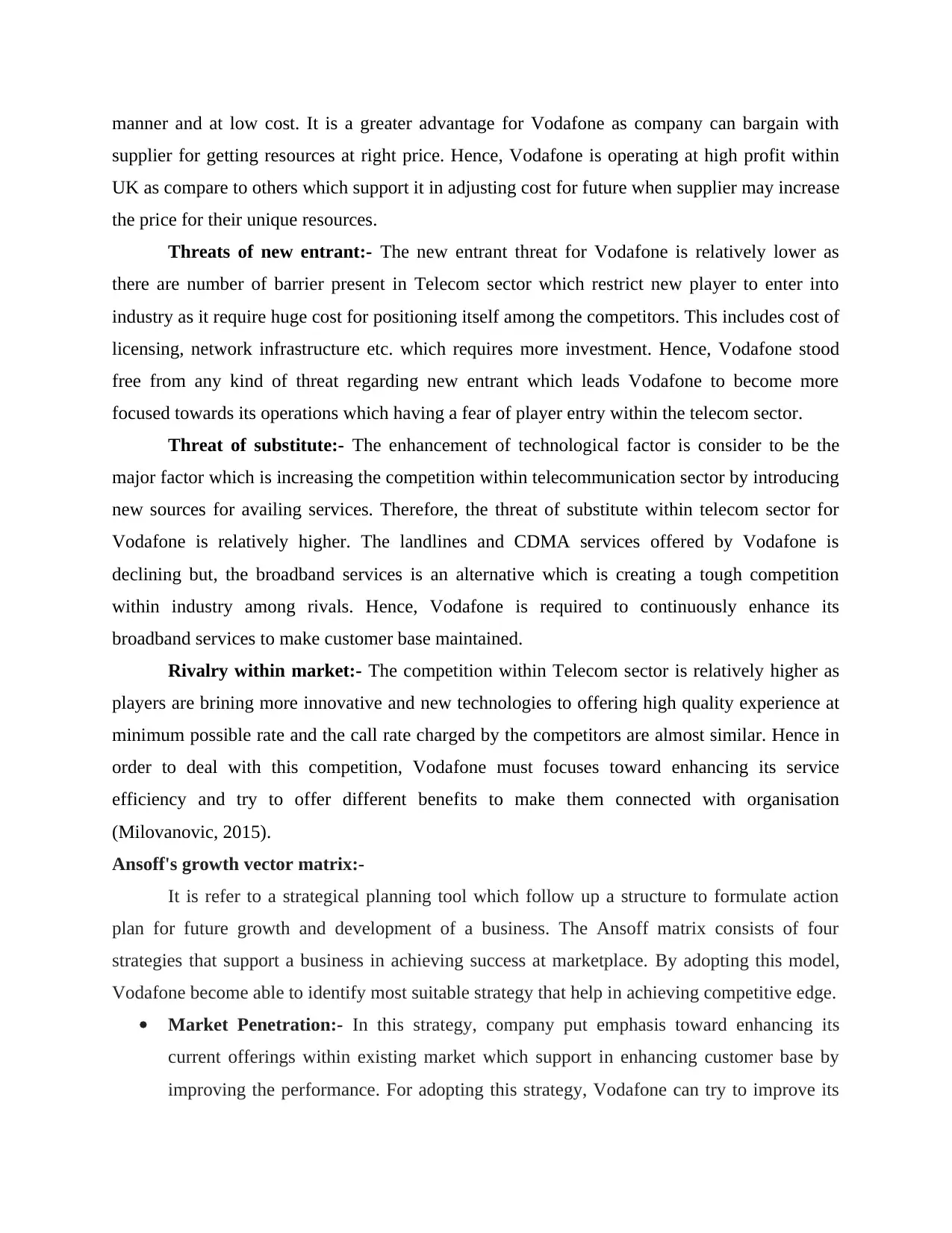
manner and at low cost. It is a greater advantage for Vodafone as company can bargain with
supplier for getting resources at right price. Hence, Vodafone is operating at high profit within
UK as compare to others which support it in adjusting cost for future when supplier may increase
the price for their unique resources.
Threats of new entrant:- The new entrant threat for Vodafone is relatively lower as
there are number of barrier present in Telecom sector which restrict new player to enter into
industry as it require huge cost for positioning itself among the competitors. This includes cost of
licensing, network infrastructure etc. which requires more investment. Hence, Vodafone stood
free from any kind of threat regarding new entrant which leads Vodafone to become more
focused towards its operations which having a fear of player entry within the telecom sector.
Threat of substitute:- The enhancement of technological factor is consider to be the
major factor which is increasing the competition within telecommunication sector by introducing
new sources for availing services. Therefore, the threat of substitute within telecom sector for
Vodafone is relatively higher. The landlines and CDMA services offered by Vodafone is
declining but, the broadband services is an alternative which is creating a tough competition
within industry among rivals. Hence, Vodafone is required to continuously enhance its
broadband services to make customer base maintained.
Rivalry within market:- The competition within Telecom sector is relatively higher as
players are brining more innovative and new technologies to offering high quality experience at
minimum possible rate and the call rate charged by the competitors are almost similar. Hence in
order to deal with this competition, Vodafone must focuses toward enhancing its service
efficiency and try to offer different benefits to make them connected with organisation
(Milovanovic, 2015).
Ansoff's growth vector matrix:-
It is refer to a strategical planning tool which follow up a structure to formulate action
plan for future growth and development of a business. The Ansoff matrix consists of four
strategies that support a business in achieving success at marketplace. By adopting this model,
Vodafone become able to identify most suitable strategy that help in achieving competitive edge.
Market Penetration:- In this strategy, company put emphasis toward enhancing its
current offerings within existing market which support in enhancing customer base by
improving the performance. For adopting this strategy, Vodafone can try to improve its
supplier for getting resources at right price. Hence, Vodafone is operating at high profit within
UK as compare to others which support it in adjusting cost for future when supplier may increase
the price for their unique resources.
Threats of new entrant:- The new entrant threat for Vodafone is relatively lower as
there are number of barrier present in Telecom sector which restrict new player to enter into
industry as it require huge cost for positioning itself among the competitors. This includes cost of
licensing, network infrastructure etc. which requires more investment. Hence, Vodafone stood
free from any kind of threat regarding new entrant which leads Vodafone to become more
focused towards its operations which having a fear of player entry within the telecom sector.
Threat of substitute:- The enhancement of technological factor is consider to be the
major factor which is increasing the competition within telecommunication sector by introducing
new sources for availing services. Therefore, the threat of substitute within telecom sector for
Vodafone is relatively higher. The landlines and CDMA services offered by Vodafone is
declining but, the broadband services is an alternative which is creating a tough competition
within industry among rivals. Hence, Vodafone is required to continuously enhance its
broadband services to make customer base maintained.
Rivalry within market:- The competition within Telecom sector is relatively higher as
players are brining more innovative and new technologies to offering high quality experience at
minimum possible rate and the call rate charged by the competitors are almost similar. Hence in
order to deal with this competition, Vodafone must focuses toward enhancing its service
efficiency and try to offer different benefits to make them connected with organisation
(Milovanovic, 2015).
Ansoff's growth vector matrix:-
It is refer to a strategical planning tool which follow up a structure to formulate action
plan for future growth and development of a business. The Ansoff matrix consists of four
strategies that support a business in achieving success at marketplace. By adopting this model,
Vodafone become able to identify most suitable strategy that help in achieving competitive edge.
Market Penetration:- In this strategy, company put emphasis toward enhancing its
current offerings within existing market which support in enhancing customer base by
improving the performance. For adopting this strategy, Vodafone can try to improve its
Paraphrase This Document
Need a fresh take? Get an instant paraphrase of this document with our AI Paraphraser
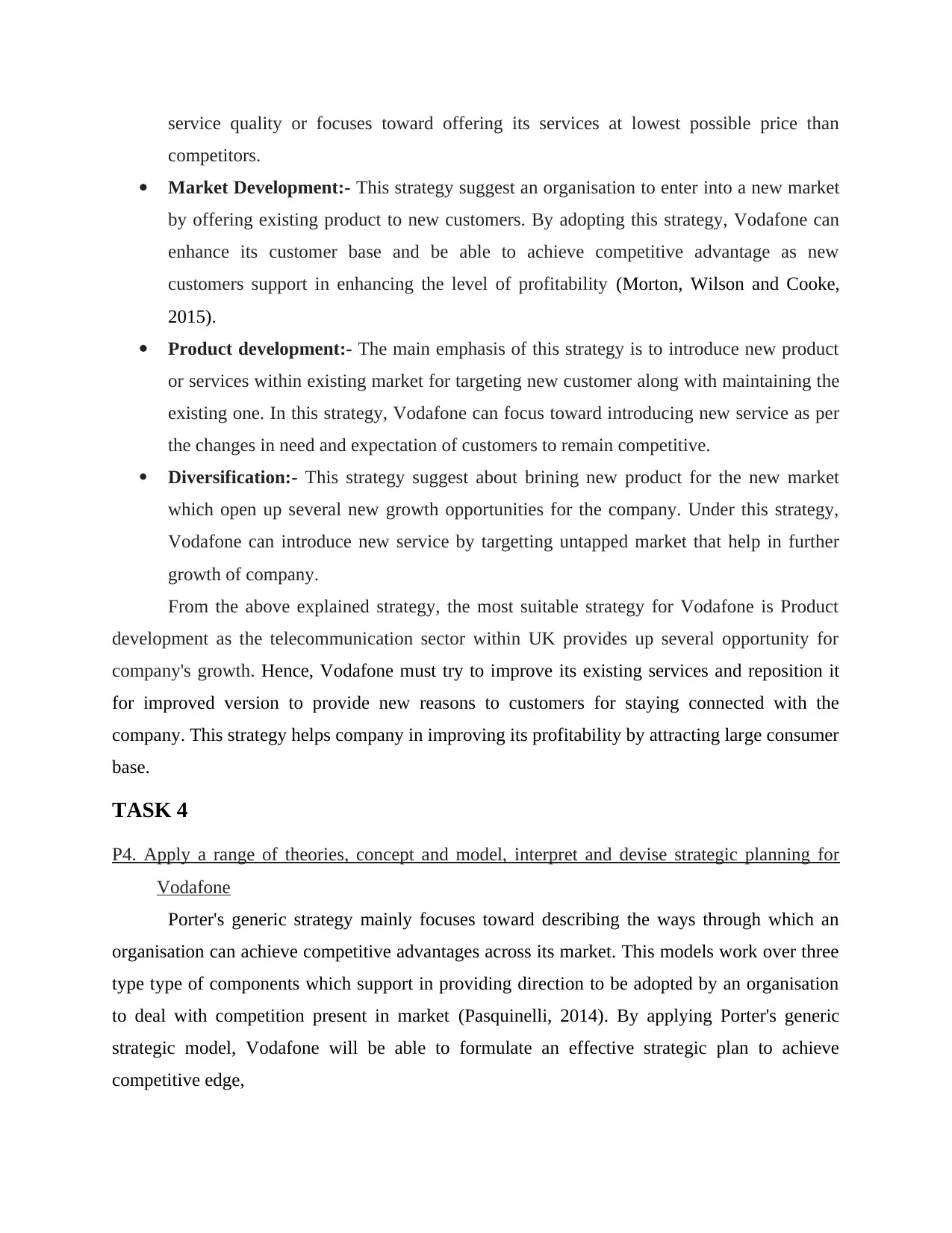
service quality or focuses toward offering its services at lowest possible price than
competitors.
Market Development:- This strategy suggest an organisation to enter into a new market
by offering existing product to new customers. By adopting this strategy, Vodafone can
enhance its customer base and be able to achieve competitive advantage as new
customers support in enhancing the level of profitability (Morton, Wilson and Cooke,
2015).
Product development:- The main emphasis of this strategy is to introduce new product
or services within existing market for targeting new customer along with maintaining the
existing one. In this strategy, Vodafone can focus toward introducing new service as per
the changes in need and expectation of customers to remain competitive.
Diversification:- This strategy suggest about brining new product for the new market
which open up several new growth opportunities for the company. Under this strategy,
Vodafone can introduce new service by targetting untapped market that help in further
growth of company.
From the above explained strategy, the most suitable strategy for Vodafone is Product
development as the telecommunication sector within UK provides up several opportunity for
company's growth. Hence, Vodafone must try to improve its existing services and reposition it
for improved version to provide new reasons to customers for staying connected with the
company. This strategy helps company in improving its profitability by attracting large consumer
base.
TASK 4
P4. Apply a range of theories, concept and model, interpret and devise strategic planning for
Vodafone
Porter's generic strategy mainly focuses toward describing the ways through which an
organisation can achieve competitive advantages across its market. This models work over three
type type of components which support in providing direction to be adopted by an organisation
to deal with competition present in market (Pasquinelli, 2014). By applying Porter's generic
strategic model, Vodafone will be able to formulate an effective strategic plan to achieve
competitive edge,
competitors.
Market Development:- This strategy suggest an organisation to enter into a new market
by offering existing product to new customers. By adopting this strategy, Vodafone can
enhance its customer base and be able to achieve competitive advantage as new
customers support in enhancing the level of profitability (Morton, Wilson and Cooke,
2015).
Product development:- The main emphasis of this strategy is to introduce new product
or services within existing market for targeting new customer along with maintaining the
existing one. In this strategy, Vodafone can focus toward introducing new service as per
the changes in need and expectation of customers to remain competitive.
Diversification:- This strategy suggest about brining new product for the new market
which open up several new growth opportunities for the company. Under this strategy,
Vodafone can introduce new service by targetting untapped market that help in further
growth of company.
From the above explained strategy, the most suitable strategy for Vodafone is Product
development as the telecommunication sector within UK provides up several opportunity for
company's growth. Hence, Vodafone must try to improve its existing services and reposition it
for improved version to provide new reasons to customers for staying connected with the
company. This strategy helps company in improving its profitability by attracting large consumer
base.
TASK 4
P4. Apply a range of theories, concept and model, interpret and devise strategic planning for
Vodafone
Porter's generic strategy mainly focuses toward describing the ways through which an
organisation can achieve competitive advantages across its market. This models work over three
type type of components which support in providing direction to be adopted by an organisation
to deal with competition present in market (Pasquinelli, 2014). By applying Porter's generic
strategic model, Vodafone will be able to formulate an effective strategic plan to achieve
competitive edge,
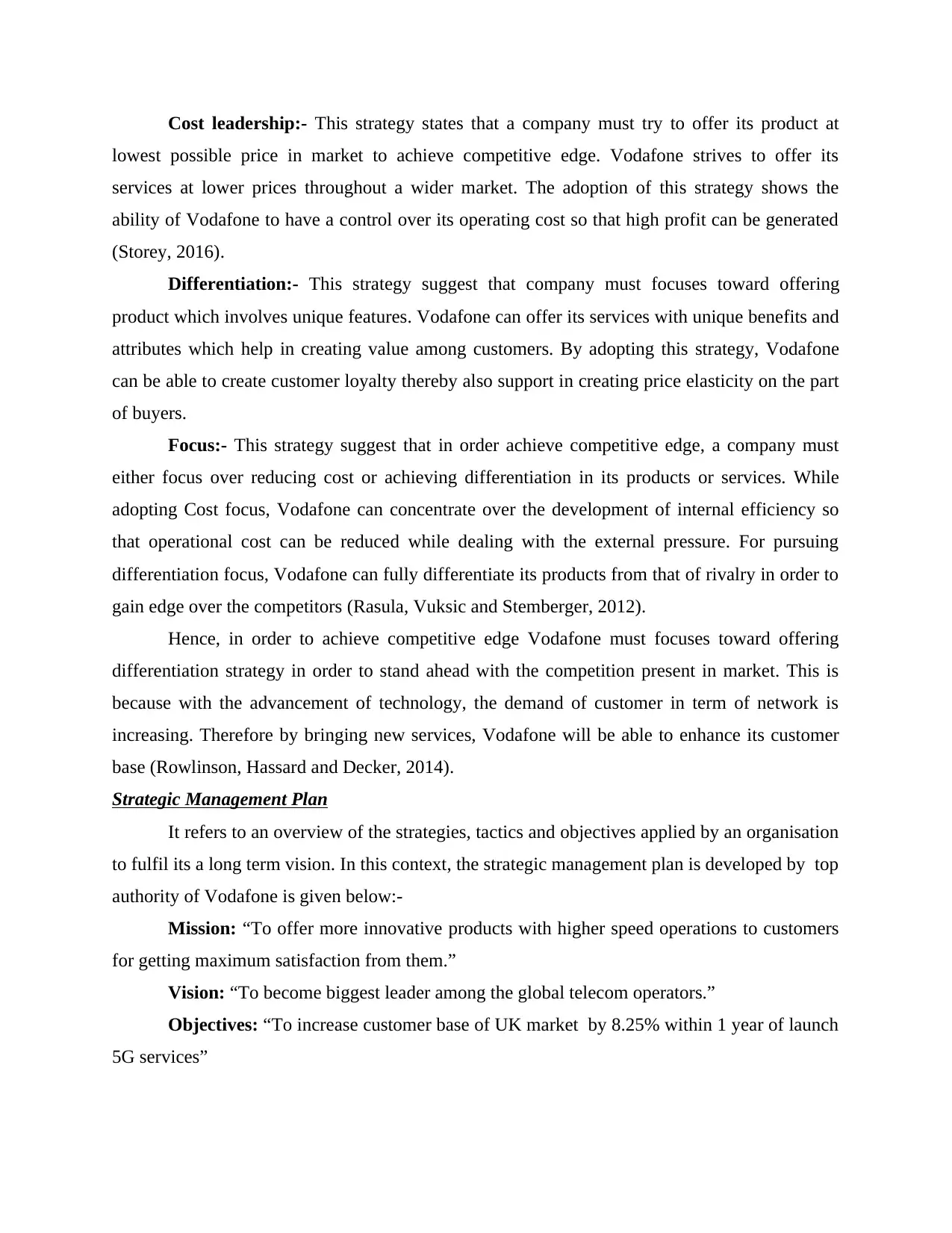
Cost leadership:- This strategy states that a company must try to offer its product at
lowest possible price in market to achieve competitive edge. Vodafone strives to offer its
services at lower prices throughout a wider market. The adoption of this strategy shows the
ability of Vodafone to have a control over its operating cost so that high profit can be generated
(Storey, 2016).
Differentiation:- This strategy suggest that company must focuses toward offering
product which involves unique features. Vodafone can offer its services with unique benefits and
attributes which help in creating value among customers. By adopting this strategy, Vodafone
can be able to create customer loyalty thereby also support in creating price elasticity on the part
of buyers.
Focus:- This strategy suggest that in order achieve competitive edge, a company must
either focus over reducing cost or achieving differentiation in its products or services. While
adopting Cost focus, Vodafone can concentrate over the development of internal efficiency so
that operational cost can be reduced while dealing with the external pressure. For pursuing
differentiation focus, Vodafone can fully differentiate its products from that of rivalry in order to
gain edge over the competitors (Rasula, Vuksic and Stemberger, 2012).
Hence, in order to achieve competitive edge Vodafone must focuses toward offering
differentiation strategy in order to stand ahead with the competition present in market. This is
because with the advancement of technology, the demand of customer in term of network is
increasing. Therefore by bringing new services, Vodafone will be able to enhance its customer
base (Rowlinson, Hassard and Decker, 2014).
Strategic Management Plan
It refers to an overview of the strategies, tactics and objectives applied by an organisation
to fulfil its a long term vision. In this context, the strategic management plan is developed by top
authority of Vodafone is given below:-
Mission: “To offer more innovative products with higher speed operations to customers
for getting maximum satisfaction from them.”
Vision: “To become biggest leader among the global telecom operators.”
Objectives: “To increase customer base of UK market by 8.25% within 1 year of launch
5G services”
lowest possible price in market to achieve competitive edge. Vodafone strives to offer its
services at lower prices throughout a wider market. The adoption of this strategy shows the
ability of Vodafone to have a control over its operating cost so that high profit can be generated
(Storey, 2016).
Differentiation:- This strategy suggest that company must focuses toward offering
product which involves unique features. Vodafone can offer its services with unique benefits and
attributes which help in creating value among customers. By adopting this strategy, Vodafone
can be able to create customer loyalty thereby also support in creating price elasticity on the part
of buyers.
Focus:- This strategy suggest that in order achieve competitive edge, a company must
either focus over reducing cost or achieving differentiation in its products or services. While
adopting Cost focus, Vodafone can concentrate over the development of internal efficiency so
that operational cost can be reduced while dealing with the external pressure. For pursuing
differentiation focus, Vodafone can fully differentiate its products from that of rivalry in order to
gain edge over the competitors (Rasula, Vuksic and Stemberger, 2012).
Hence, in order to achieve competitive edge Vodafone must focuses toward offering
differentiation strategy in order to stand ahead with the competition present in market. This is
because with the advancement of technology, the demand of customer in term of network is
increasing. Therefore by bringing new services, Vodafone will be able to enhance its customer
base (Rowlinson, Hassard and Decker, 2014).
Strategic Management Plan
It refers to an overview of the strategies, tactics and objectives applied by an organisation
to fulfil its a long term vision. In this context, the strategic management plan is developed by top
authority of Vodafone is given below:-
Mission: “To offer more innovative products with higher speed operations to customers
for getting maximum satisfaction from them.”
Vision: “To become biggest leader among the global telecom operators.”
Objectives: “To increase customer base of UK market by 8.25% within 1 year of launch
5G services”
⊘ This is a preview!⊘
Do you want full access?
Subscribe today to unlock all pages.

Trusted by 1+ million students worldwide
1 out of 15
Related Documents
Your All-in-One AI-Powered Toolkit for Academic Success.
+13062052269
info@desklib.com
Available 24*7 on WhatsApp / Email
![[object Object]](/_next/static/media/star-bottom.7253800d.svg)
Unlock your academic potential
Copyright © 2020–2025 A2Z Services. All Rights Reserved. Developed and managed by ZUCOL.




